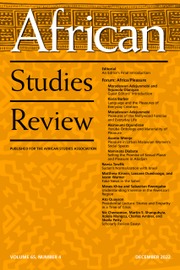Part of review forum on “Children of the Soil: The Power of Built Form in Urban Madagascar”
Indigeneity Rethought
Children of the Soil presses readers to approach political belonging, and particularly Indigeneity, beyond nationalist land-based frameworks. Work on Indigeneity in Africa has largely focused on groups that can make claim to the international legal conventions that provide recognition to Indigenous and First Nation peoples, or on the distinction between European settlers and Africans, with the latter implicitly falling into the category of Indigenous. Parallel to this work, scholars have raised concerns about the perils of indigeneity claims. Studies of autochthony and xenophobia have argued that exclusionary claims to indigeneity and authenticity have undergirded acts of violence in countries such as Côte d’Ivoire and South Africa against other Black Africans who are classified as “foreign.” At the basis of much of this work is ultimately the question of who can lay claim to the privileges of belonging (whether ethnic or national) based on links to land and/or the nation-state. Although Rijke-Epstein engages with similar themes, her methodological focus on non-human actors as key to the making of politics points readers to a world of Indigeneity emergent from oceans, objects, and ancestors.
Rijke-Epstein asks us to reconsider our understandings of settlerdom and Indigeneity by tracing their historical transformation through an analysis of the built environment of Mahajanga, a small town on the northwest coast of Madagascar. She begins her narrative with the landscape that existed before Mahajanga emerged as a town, describing its riverine systems, position as a mediating location between ocean and land, and its grasses (suited for pasture)—all of which drew humans towards it. The book then analyzes various waves of settlement and settlerdom through their material remains. The early rule of the town emerged through cooperation between the “Antalaotra,” traders from the Indian Ocean world who also created kin relations with Malagasy, and the Sakalava Kingdom. The Sakalava signaled their power by largely prohibiting not only the Antalaotra, but other seafarers such as the Dutch, from building permanent settlements on the land. This rule set a precedent that belonging was marked through certain kinds of material presence. Even after the prohibition was lifted, the control of the built environment remained a tool of power whose historical iterations are explored in chapters that study Merina and then French colonial rule. Running parallel to these acts of power, however, is the story of the Antalaotra, and especially the Comorian migrants who become known as the zanatany (children of the soil) and establish themselves in Mahajanga.
The zanatany complicate existing understandings in African Studies literature about settlerdom. They do not arrive to conquer. Some arrive under French colonial labor policies, others as traders and others simply seeking new opportunities. As Rijke-Epstein (19) suggests, there are different “ethics” of settlerdom and they matter for shaping the political status and trajectories of various groups. By placing different moments of conquest and settlerdom in parallel, she challenges existing assumptions about who we classify as a settler and why. What is the difference in status, for instance, between Merina Malagasies and zanatany, neither of them indigenous to Mahajanga? Both groups create links to the urban through the act of construction but had different experiences of recognition. Despite similar processes of claiming belonging, in moments of crisis, zanatany claims were thrown into question, with many Comorians killed or expelled from Madagascar in the 1970s. Children of the Soil forefronts various distinctions in settlement as a historical act, highlighting the need to carefully parse the intentions, origins, and actions of different groups and moments of settlement.
The distinction, of course, between Merina and zanatany claims are their different relations to land-based belonging. Merina can claim Indigeneity due to them being from Madagascar. While recognizing land’s salience, Rijke-Epstein presses readers to complicate its assumed primacy as a source of political belonging. The zanatany’s ultimate claim after all, is not just that they are a different kind of settler, but that they are Indigenous. This claim forces Rijke-Epstein to battle with the question of whether certain kinds of settlers can become Indigenous, which her account seems to suggest is possible. This can only be the case, however, if something other than land is taken as the basis of Indigeneity. Comorian Indigeneity arguably initially finds legitimacy through their relationship to the Indian Ocean world. As a port city, Mahajanga, although on land, can never be considered purely of the land. The ocean has been integral to Mahajanga’s making and their belonging to this oceanic world provides the initial basis for Comorian distinction from other kinds of settlers. This oceanic belonging is transformed into a claim to urban belonging through construction (largely of housing), which enables Comorians to shift their classification from Antalaotra (people of the sea) to zanatany (children of the soil). Again, processes beyond landed histories are what their claims are rooted in. This, however, has repercussions not just for imagining Indigeneity beyond land, but also for how Indigeneity and its relationship to land is imagined in African Studies. Where does land stand in a politics that takes the non-human world and the ocean seriously as sites from which claims to belonging can be made? While the expulsion of the zanatany could be read as highlighting the tenuous nature of their construction-based Indigeneity, we discover that Comorian spirits continue to inhabit their former homes, tormenting the Malagasy who now occupy them. The non-human world—both material and immaterial—shows us that even when official nationalist politics appear to deny certain claims to belonging, everyday life reveals their durability. Children of the Soil suggests that relations to land must sometimes exist in tension with other sources and processes of belonging. Tracing these other sources of belonging as Rijke-Epstein does, holds promise to open up new visions of politics, affect, and conviviality in contemporary understandings of African history.


